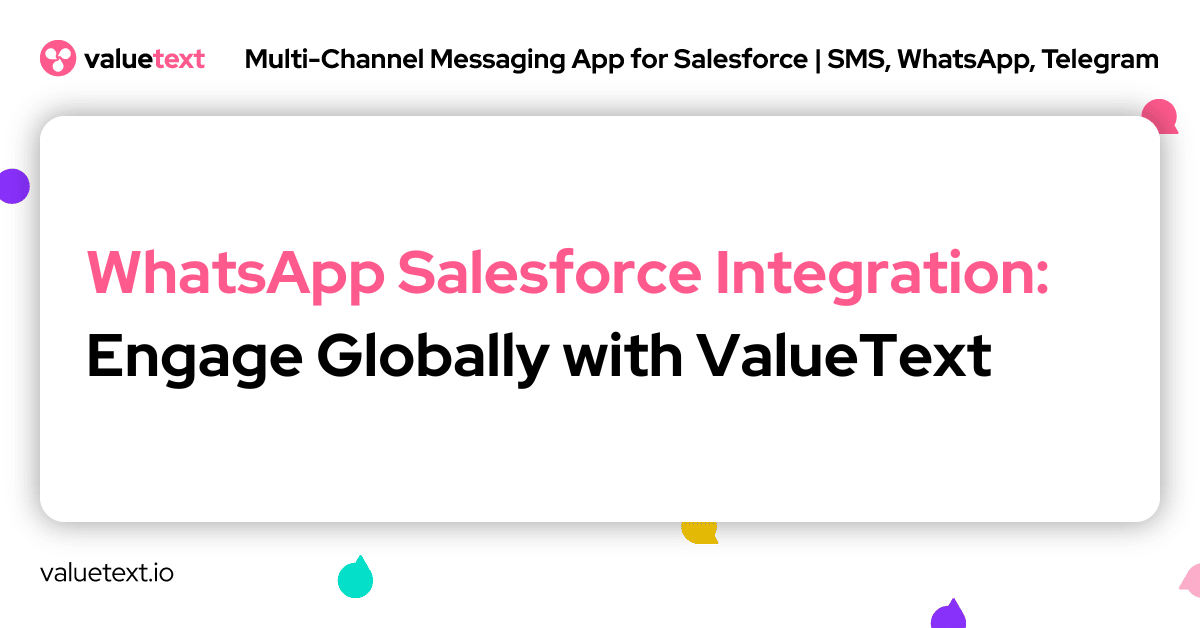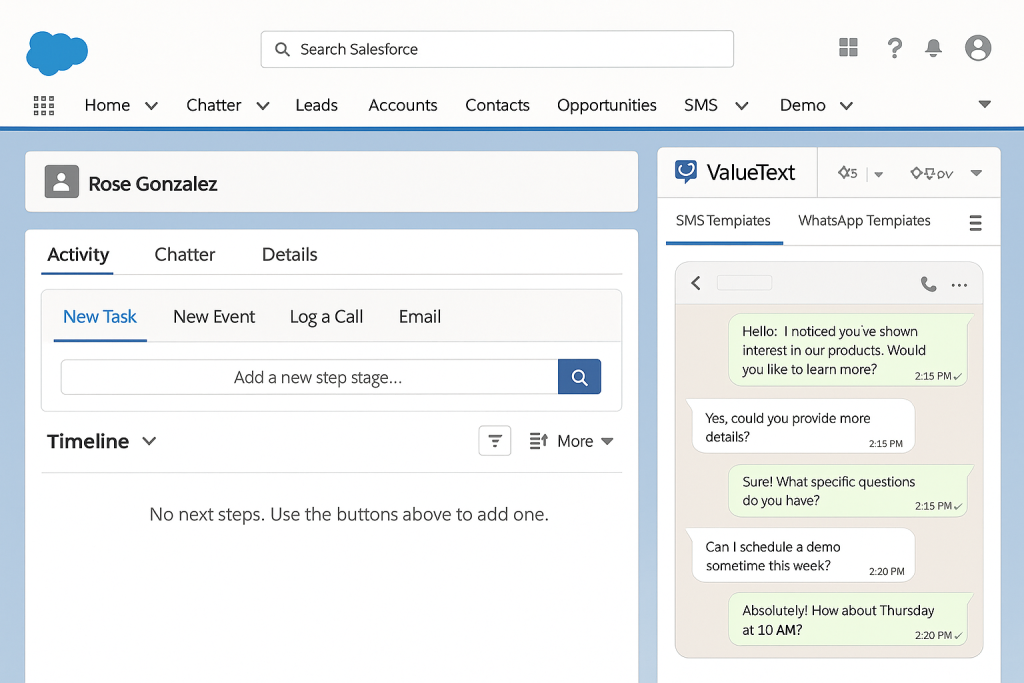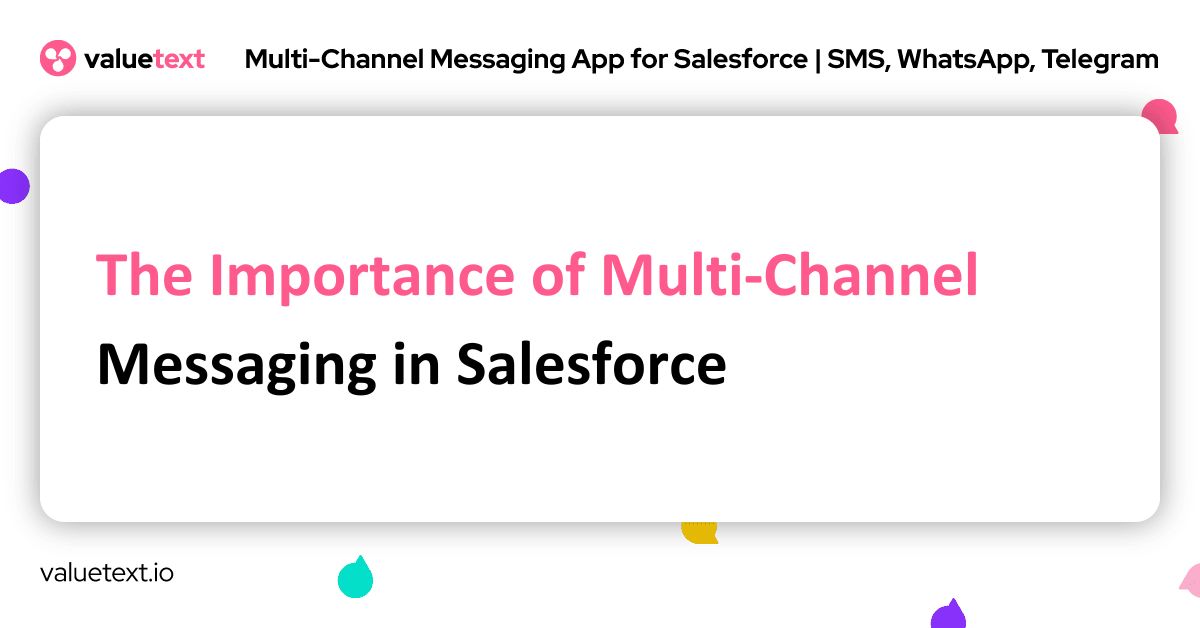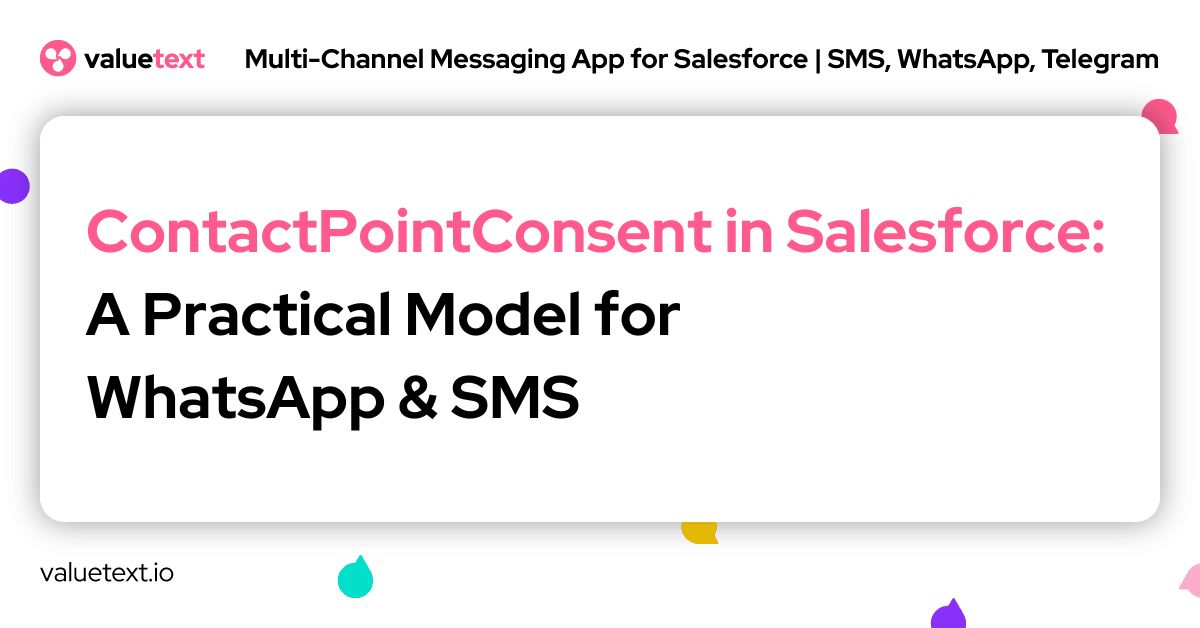30 Jun

Imagine this: A customer in Brazil messages your support team via WhatsApp Salesforce integration about a delayed order. Your global team responds instantly, updates the order status in Salesforce, and delivers a personalized solution—all without leaving the CRM. This is the power of WhatsApp Salesforce integration, and ValueText makes it seamless for businesses worldwide. With over 2 billion users across 180+ countries, WhatsApp is where your customers are. In this guide, we’ll show you how ValueText helps you connect, engage, and solve real-world challenges using WhatsApp within Salesforce.
Why WhatsApp Salesforce Integration Boosts Engagement?
WhatsApp isn’t just a messaging app—it’s a global communication hub. For Salesforce users, integrating WhatsApp means meeting customers on their preferred platform while keeping all interactions centralized in your CRM. Here’s why it’s a game-changer:
- Reach Customers Instantly: 98% of WhatsApp messages are opened, far surpassing email’s 20% open rate.
- Build Trust with Personalisation: Use Salesforce data to send tailored messages, such as order updates or product recommendations, thus increasing customer satisfaction.
- Scale Globally: WhatsApp supports 60+ languages, making it ideal for businesses with international customers.
ValueText empowers teams to turn these benefits into actionable results, solving everyday customer engagement challenges with ease.
👉🏻 WhatsApp’s business page
Solving Real Challenges with WhatsApp Salesforce Integration
Let’s dive into a common scenario: A global e-commerce brand struggles to manage customer inquiries across time zones. Emails go unanswered, and phone support is costly. Here’s how ValueText’s WhatsApp Salesforce integration solves this:

Streamline Global Support with Two-Way Messaging
ValueText lets your team send and receive WhatsApp messages directly from Salesforce records. For example, a customer in the UK can ask about a product, and your team in the US can reply instantly with a catalog PDF—all logged in the customer’s Salesforce profile. This two-way communication cuts response times and consequently keeps conversations contextual.
Automate Responses for 24/7 Availability
Time zone differences shouldn’t mean missed opportunities. ValueText’s AI chatbot can greet customers in their language, answer FAQs (e.g., “Where’s my order?”), and escalate complex queries to your team. Imagine a customer in Japan messaging at 2 AM IST—ValueText responds automatically, thereby ensuring they feel heard.
Engage Groups for Community Building
Hosting a product launch or webinar? ValueText lets you create WhatsApp group chats from Salesforce campaigns. Invite leads to a group, share event details, and answer questions live. A fitness brand, for instance, used this to promote a global yoga challenge, engaging 500+ participants in one group chat.
Unique Features That Set ValueText Apart
ValueText isn’t just another integration—it’s built to make WhatsApp work smarter for Salesforce users worldwide. Here’s what makes it stand out:
Multilingual Messaging for Global Reach
ValueText supports WhatsApp’s 60+ languages, thus letting you communicate in your customers’ native tongues. For example, send order confirmations in Spanish to a customer in Mexico and in Hindi to a customer in India—all from the same Salesforce dashboard.
Interactive Message Templates
Go beyond text with ValueText’s rich media templates for WhatsApp Salesforce integration. Share images, videos, or quick-reply buttons (e.g., “Track Order” or “Speak to Agent”) to make interactions engaging. A travel agency used this to share itinerary videos, increasing booking confirmations by 15%.
Seamless Team Collaboration
Multiple team members can manage WhatsApp chats within Salesforce. Assign conversations to specific reps, add internal notes, and track progress—all without leaving the CRM. This ensures no customer query slips through the cracks.
3 Steps to Get Started with WhatsApp Salesforce Integration
Ready to connect with your global customers? Here’s how to set up ValueText’s WhatsApp integration in Salesforce:
- Install ValueText: Download from the Salesforce AppExchange and set up in under 15 minutes—no coding needed.
- Create WhatsApp Workflows: Build templates and automate responses using Salesforce Flow to match your business needs.
- Start Engaging: Send your first message and monitor interactions via ValueText’s analytics dashboard.
Your team can be live on WhatsApp in less than a day, thereby transforming how you engage customers worldwide.
Tips to Maximize WhatsApp Engagement Globally
- Leverage Time-Sensitive Offers: Send flash sale alerts with countdown timers to create urgency.
- Use WhatsApp Status: Share updates or promotions via WhatsApp Status to reach customers who don’t open messages.
- Respect Preferences: Let customers opt-in/out easily to build trust and comply with global privacy standards.
Conclusion: Connect Globally with ValueText
WhatsApp Salesforce integration opens doors to unparalleled customer engagement, and ValueText makes it effortless. From two-way messaging to multilingual support, ValueText helps you connect with 2 billion+ WhatsApp users while keeping everything centralized in Salesforce. Ready to transform your global customer experience?
👉 Book a 15-minute demo and send your first WhatsApp message today!
Author : Nikhil — Senior Client Consultant, ValueText
Nikhil leads global marketing and Salesforce integration initiatives for ValueText’s SaaS messaging platform. He writes high-impact blogs, guides new users through onboarding and training, and drives adoption of SMS / WhatsApp automation across industries. Passionate about the crossroads of marketing, technology, and client success.






